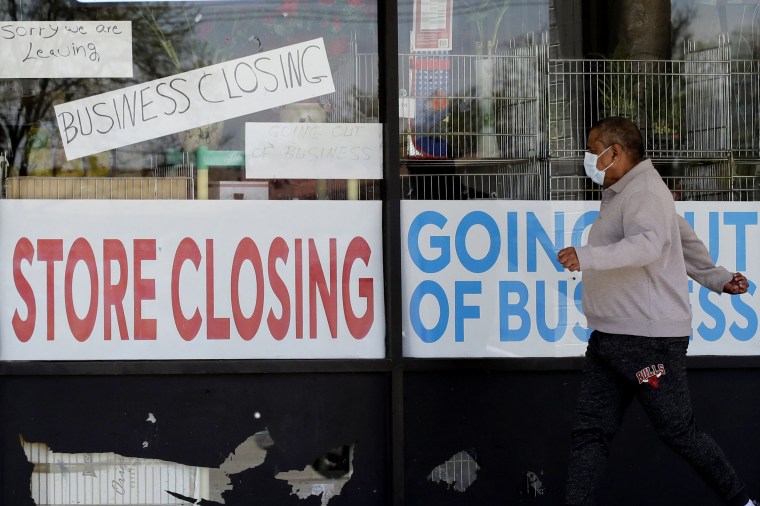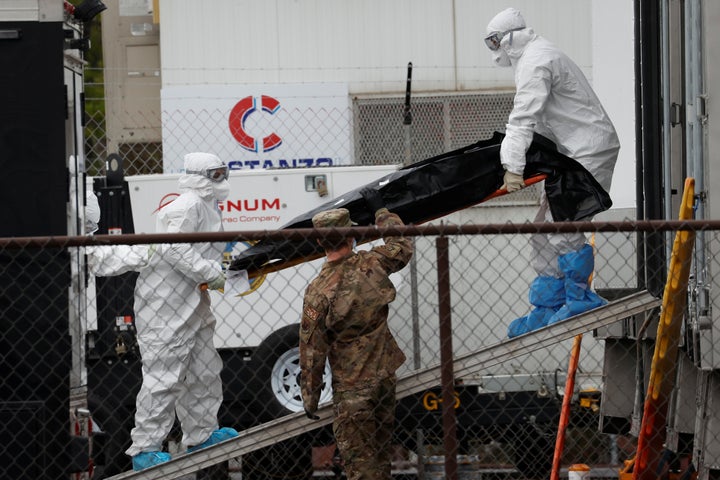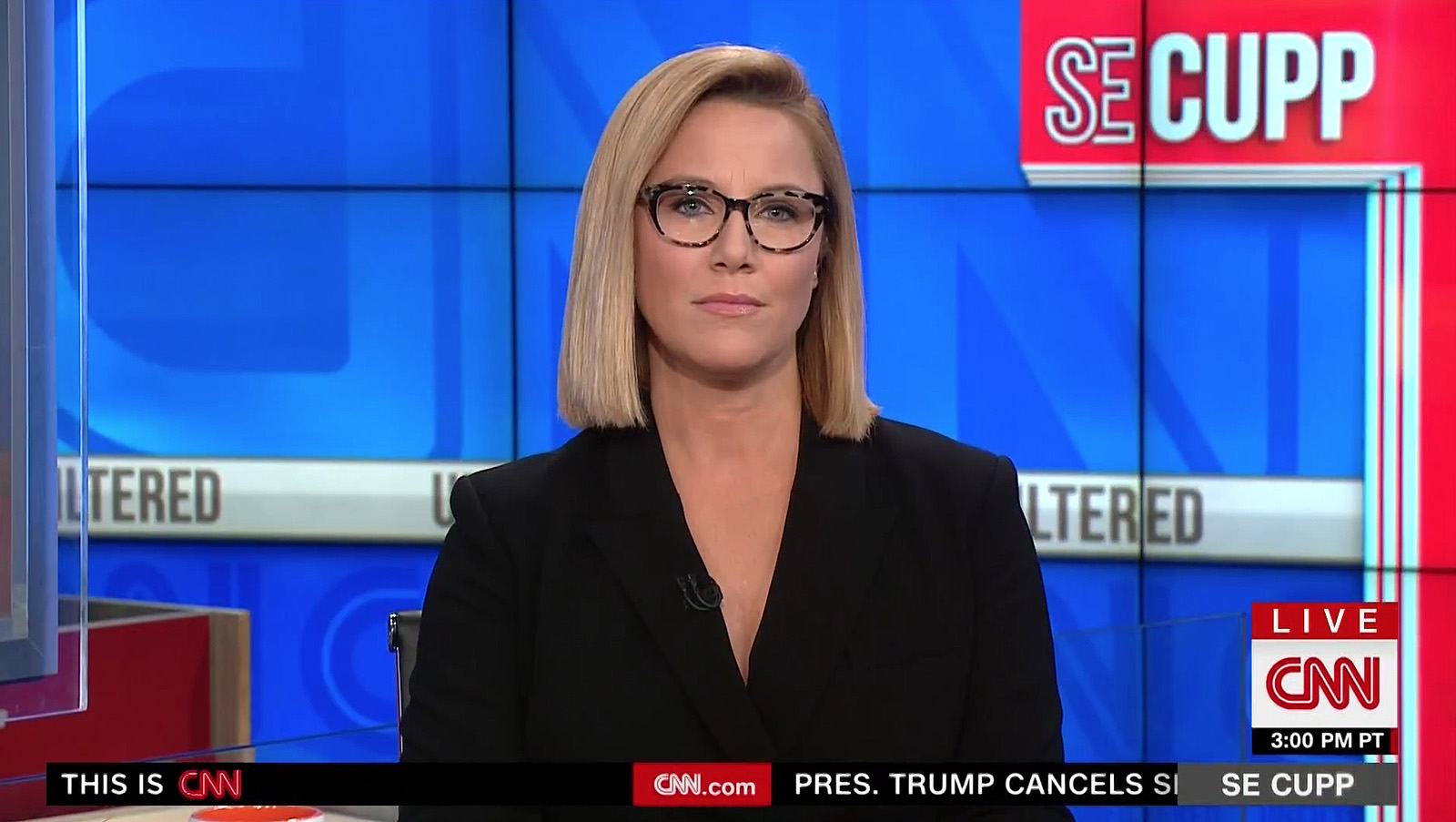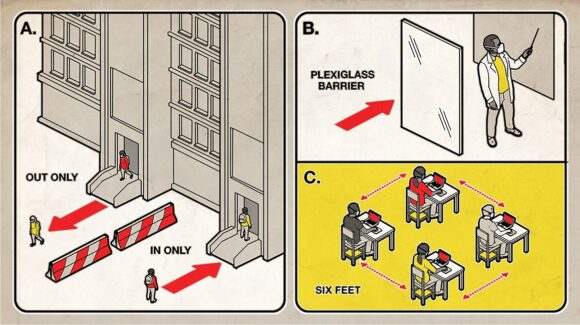Dear Commons Community.
Tom Friedman has a column this morning entitled, How We Broke the World, that presents the case that greed and globalization have set us up for disaster. He sees a destabilizing trend in major crises that we have experienced in the past twenty years including the current coronavirus pandemic. Pandemics are no longer just biological — they are now geopolitical, financial and atmospheric, too. Below is the entire column. Lots to think about!
Tony
——————————————————-
New York Times
How We Broke the World
By Thomas L. Friedman
May 31, 2020
If recent weeks have shown us anything, it’s that the world is not just flat. It’s fragile.
And we’re the ones who made it that way with our own hands. Just look around. Over the past 20 years, we’ve been steadily removing man-made and natural buffers, redundancies, regulations and norms that provide resilience and protection when big systems — be they ecological, geopolitical or financial — get stressed. We’ve been recklessly removing these buffers out of an obsession with short-term efficiency and growth, or without thinking at all.
At the same time, we’ve been behaving in extreme ways — pushing against, and breaching, common-sense political, financial and planetary boundaries.
And, all the while, we’ve taken the world technologically from connected to interconnected to interdependent — by removing more friction and installing more grease in global markets, telecommunications systems, the internet and travel. In doing so, we’ve made globalization faster, deeper, cheaper and tighter than ever before. Who knew that there were regular direct flights from Wuhan, China, to America?
Put all three of these trends together and what you have is a world more easily prone to shocks and extreme behaviors — but with fewer buffers to cushion those shocks — and many more networked companies and people to convey them globally.
This, of course, was revealed clearly in the latest world-spanning crisis — the coronavirus pandemic. But this trend of more frequent destabilizing crises has been building over the past 20 years: 9/11, the Great Recession of 2008, Covid-19 and climate change. Pandemics are no longer just biological — they are now geopolitical, financial and atmospheric, too. And we will suffer increasing consequences unless we start behaving differently and treating Mother Earth differently.
Note the pattern: Before each crisis I mentioned, we first experienced what could be called a “mild” heart attack, alerting us that we had gone to extremes and stripped away buffers that had protected us from catastrophic failure. In each case, though, we did not take that warning seriously enough — and in each case the result was a full global coronary.
“We created globalized networks because they could make us more efficient and productive and our lives more convenient,” explained Gautam Mukunda, the author of “Indispensable: When Leaders Really Matter.” “But when you steadily remove their buffers, backup capacities and surge protectors in pursuit of short-term efficiency or just greed, you ensure that these systems are not only less resistant to shocks, but that we spread those shocks everywhere.”
Sept. 11, 2001
Let’s start with 9/11. You could view Al Qaeda and its leader, Osama bin Laden, as political pathogens that emerged out of the Middle East after 1979. “Islam lost its brakes in 1979” — its resistance to extremism was badly compromised — said Mamoun Fandy, an expert on Arab politics.
That was the year that Saudi Arabia lurched backward, after Islamist extremists took over the Grand Mosque in Mecca and an Islamic revolution in Iran brought Ayatollah Ruhollah Khomeini to power. Those events set up a competition between Shiite Iran and Sunni Saudi Arabia over who was the real leader of the Muslim world. That battle coincided with a surge in oil prices that gave both fundamentalist regimes the resources to propagate their brands of puritanical Islam, through mosques and schools, across the globe.
In doing so, they together weakened any emerging trends toward religious and political pluralism — and strengthened austere fundamentalism and its violent fringes.
Remember: The Muslim world was probably at its most influential, culturally, scientifically and economically, in the Middle Ages, when it was a rich and diverse polyculture in Moorish Spain.
Diverse ecosystems, in nature and in politics, are always more resilient than monocultures. Monocultures in agriculture are enormously susceptible to disease — one virus or germ can wipe out an entire crop. Monocultures in politics are enormously susceptible to diseased ideas.
Thanks to Iran and Saudi Arabia, the Arab-Muslim world became much more of a monoculture after 1979. And the idea that violent Islamist jihadism would be the engine of Islam’s revival — and that purging the region of foreign influences, particularly American, was its necessary first step — gained much wider currency.
This ideological pathogen spread — through mosques, cassette tapes and then the internet — to Pakistan, North Africa, Europe, India and Indonesia.
The warning bell that this idea could destabilize even America rang on Feb. 26, 1993, at 12:18 p.m., when a rental van packed with explosives blew up in the parking garage below the 1 World Trade Center building in Manhattan. The bomb failed to bring down the building as intended, but it badly damaged the main structure, killing six people and injuring more than 1,000.
The mastermind of the attack, Ramzi Ahmed Yousef, a Pakistani, later told F.B.I. agents that his only regret was that the 110-story tower did not collapse into its twin and kill thousands.
What happened next we all know: The direct hits on both twin towers on Sept. 11, 2001, which set off a global economic and geopolitical crisis that ended with the United States spending several trillion dollars trying to immunize America against violent Islamic extremism — via a massive government-directed surveillance system, renditions and airport metal detectors — and by invading the Middle East.
The United States and its allies toppled the dictators in Iraq and Afghanistan, hoping to stimulate more political pluralism, gender pluralism and religious and educational pluralism — antibodies to fanaticism and authoritarianism. Unfortunately, we didn’t really know how to do this in such distant lands, and we botched it; the natural pluralistic antibodies in the region also proved to be weak.
Either way — as in biology, so, too, in geopolitics — the virus of Al Qaeda mutated, picking up new elements from its hosts in Iraq and Afghanistan. As a result, violent Islamic extremism became even more virulent, thanks to subtle changes in its genome that transformed it into ISIS, or the Islamic State.
This emergence of ISIS, and parallel mutations in the Taliban, forced the United States to remain in the area to just manage the outbreaks, but nothing more.
The Great Recession
The 2008 global banking crisis played out in similar ways. The warning was delivered by a virus known by the initials LTCM — Long-Term Capital Management.
LTCM was a hedge fund set up in 1994 by the investment banker John Meriweather, who assembled a team of mathematicians, industry veterans and two Nobel Prize winners. The fund used mathematical models to predict prices and tons of leverage to amplify its founding capital of $1.25 billion to make massive, and massively profitable, arbitrage bets.
It all worked — until it didn’t.
“In August 1998,” recalled Business Insider, “Russia defaulted on its debt. Three days later, markets all over the world started sinking. Investors began pulling out left and right. Swap spreads were at unbelievable levels. Everything was plummeting. In one day, Long-Term lost $553 million, 15 percent of its capital. In one month it lost almost $2 billion.”
Hedge funds lose money all the time, default and go extinct. But LTCM was different.
The firm had leveraged its bets with so much capital from so many different big global banks — with no trading transparency, so none of its counterparties had a picture of LTCM’s total exposure — that if it were allowed to go bankrupt and default, it would have exacted huge losses on dozens of investments houses and banks on Wall Street and abroad.
More than $1 trillion was at risk. It took a $3.65 billion bailout package from the Federal Reserve to create herd immunity from LTCM for the Wall Street bulls.
The crisis was contained and the lesson was clear: Don’t let anyone make such big, and in some ways extreme, bets with such tremendous leverage in a global banking system where there is no transparency as to how much a single player has borrowed from many different sources.
A decade later, the lesson was forgotten, and we got the full financial disaster of 2008.
This time we were all in the casino. There were four main financial vehicles (that became financial pathogens) that interacted to create the global crisis of 2008. They were called subprime mortgages, adjustable rate mortgages (ARMs), commercial mortgage-backed securities (C.M.B.S.) and collateralized debt obligations (C.D.O.s).
Banks and less-regulated financial institutions engaged in extremely reckless subprime and adjustable rate mortgage lending, and then they and others bundled these mortgages into mortgage-backed securities. Meanwhile, rating agencies classified these bonds as much less risky than they really were.
The whole system depended on housing prices endlessly rising. When the housing bubble burst — and many homeowners could not pay their mortgages — the financial contagion infected huge numbers of global banks and insurance companies, not to mention millions of mom-and-pops.
We had breached the boundaries of financial common sense. With the world’s financial system more hyper-connected and leveraged than ever, only huge bailouts by central banks prevented a full-on economic pandemic and depression caused by failing commercial banks and stock markets.
In 2010, we tried to immunize the banking system against a repeat with the Dodd-Frank Wall Street Reform and Consumer Protection Act in America and with the Basel III new capital and liquidity standards adopted by banking systems around the world. But ever since then, and particularly under the Trump administration, financial services companies have been lobbying, often successfully, to weaken these buffers, threatening a new financial contagion down the road.
This one could be even more dangerous because computerized trading now makes up more than half of stock trading volume globally. These traders use algorithms and computer networks that process data at a thousandth or millionth of a second to buy and sell stocks, bonds or commodities.
Alas, there is no herd immunity to greed.
Covid-19
I don’t think that I need to spend much time on the Covid-19 pandemic, except to say that the warning sign was also there. It appeared in late 2002 in the Guangdong province of southern China. It was a viral respiratory illness caused by a coronavirus — SARS-CoV — known for short as SARS.
As the Centers for Disease Control and Prevention website notes, “Over the next few months, the illness spread to more than two dozen countries in North America, South America, Europe, and Asia” before it was contained. More than 8,000 people worldwide became sick, including close to 800 who died. The United States had eight confirmed cases of infection and no deaths.
The coronavirus that caused SARS was hosted by bats and palm civets. It jumped to humans because we had been pushing and pushing high-density urban population centers more deeply into wilderness areas, destroying that natural buffer and replacing it with monoculture crops and concrete.
When you simultaneously accelerate development in ways that destroy more and more natural habitats and then hunt for more wildlife there, “the natural balance of species collapses due to loss of top predators and other iconic species, leading to an abundance of more generalized species adapted to live in human-dominated habitats,” Johan Rockstrom, the chief scientist at Conservation International, explained to me.
These include rats, bats, palm civets and some primates, which together host a majority of all known viruses that can be passed on to humans. And when these animals are then hunted, trapped and taken to markets — in particular in China, Central Africa and Vietnam, where they are sold for food, traditional medicine, potions and pets — they endanger humans, who did not evolve with these viruses.
SARS jumped from mainland China to Hong Kong in February 2003, when a visiting professor, Dr. Liu Jianlun, who unknowingly had SARS, checked into Room 911 at Hong Kong’s Metropole Hotel.
Yup, Room 9-1-1. I am not making that up.
“By the time he checked out,” The Washington Post reported, “Liu had spread a deadly virus directly to at least eight guests. They would unknowingly take it with them to Singapore, Toronto, Hong Kong and Hanoi, where the virus would continue to spread. Of more than 7,700 cases of severe acute respiratory syndrome tallied so far worldwide, the World Health Organization estimates that more than 4,000 can be traced to Liu’s stay on the ninth floor of the Metropole Hotel.”
It is important to note, though, that SARS was contained by July 2003 before becoming a full-fledged pandemic — thanks in large part to rapid quarantines and tight global cooperation among public health authorities in many countries. Collaborative multinational governance proved to be a good buffer.
Alas, that was then. The latest coronavirus is aptly named SARS-CoV-2 — with emphasis on the number 2. We don’t yet know for sure where this coronavirus that causes the disease Covid-19 came from, but it is widely suspected to have jumped to a human from a wild animal, maybe a bat, in Wuhan, China. Similar jumps are bound to happen more and more as we keep stripping away nature’s natural biodiversity and buffers.
“The more simplified and less diverse ecological systems become, especially in huge and ever-expanding urban areas, the more we will become the targets of these emerging pests, unbuffered by the vast array of other species in a healthy ecosystem,” explained Russ Mittermeier, the head of Global Wildlife Conservation and one of the world’s top experts on primates.
What we know for sure, though, is that some five months after this coronavirus jumped into a human in Wuhan, more than 100,000 Americans were dead and more than 40 million unemployed.
While the coronavirus arrived in the U.S. via both Europe and Asia, most Americans probably don’t realize just how easy it was for this pathogen to get here. From December through March, when the pandemic was launching, there were some 3,200 flights from China to major U.S. cities, according to a study by ABC News. Among those were 50 direct flights from Wuhan. From Wuhan! How many Americans had even heard of Wuhan?
The vastly expanded global network of planes, trains and ships, combined with far too few buffers of global cooperation and governance, combined with the fact that there are almost eight billion people on the planet today (compared with 1.8 billion when the 1918 flu pandemic hit), enabled this coronavirus to spread globally in the blink of an eye.
Climate Catastrophe
You have to be in total denial not to see all of this as one giant flashing warning signal for our looming — and potentially worst — global disaster, climate change.
I don’t like the term climate change to describe what’s coming. I much prefer “global weirding,” because the weather getting weird is what is actually happening. The frequency, intensity and cost of extreme weather events all increase. The wets get wetter, the hots get hotter, the dry periods get drier, the snows get heavier, the hurricanes get stronger.
Weather is too complex to attribute any single event to climate change, but the fact that extreme weather events are becoming more frequent and more expensive — especially in a world of crowded cities like Houston and New Orleans — is indisputable.
The wise thing would be for us to get busy preserving all of the ecological buffers that nature endowed us with, so we could manage what are now the unavoidable effects of climate change and focus on avoiding what would be unmanageable consequences.
Because, unlike biological pandemics like Covid-19, climate change does not “peak.” Once we deforest the Amazon or melt the Greenland ice sheet, it’s gone — and we will have to live with whatever extreme weather that unleashes.
One tiny example: The Washington Post noted that the Edenville Dam that burst in Midland, Mich., this month, forcing 11,000 people out of their homes after unusually heavy spring rains, “took some residents by surprise, but it didn’t come as such a shock to hydrologists and civil engineers, who have warned that climate change and increased runoff from development is putting more pressure on poorly maintained dams, many of them built — like those in Midland — to generate power early in the 20th century.”
But unlike the Covid-19 pandemic, we have all the antibodies we need to both live with and limit climate change. We can have herd immunity if we just preserve and enhance the buffers that we know give us resilience. That means reducing CO₂ emissions, protecting forests that store carbon and filter water and the ecosystems and species diversity that keep them healthy, protecting mangroves that buffer storm surges and, more generally, coordinating global governmental responses that set goals and limits and monitor performance.
As I look back over the last 20 years, what all four of these global calamities have in common is that they are all “black elephants,” a term coined by the environmentalist Adam Sweidan. A black elephant is a cross between “a black swan” — an unlikely, unexpected event with enormous ramifications — and the “elephant in the room” — a looming disaster that is visible to everyone, yet no one wants to address.
In other words, this journey I have taken you on may sound rather mechanistic and inevitable. It was not. It was all about different choices, and different values, that humans and their leaders brought to bear at different times in our globalizing age — or didn’t.
Technically speaking, globalization is inevitable. How we shape it is not.
Or, as Nick Hanauer, the venture capitalist and political economist, remarked to me the other day: “Pathogens are inevitable, but that they turn into pandemics is not.’’
We decided to remove buffers in the name of efficiency; we decided to let capitalism run wild and shrink our government’s capacities when we needed them most; we decided not to cooperate with one another in a pandemic; we decided to deforest the Amazon; we decided to invade pristine ecosystems and hunt their wildlife. Facebook decided not to restrict any of President Trump’s incendiary posts; Twitter did. And too many Muslim clerics decided to let the past bury the future, not the future bury the past.
That’s the uber lesson here: As the world gets more deeply intertwined, everyone’s behavior — the values that each of us bring to this interdependent world — matters more than ever. And, therefore, so does the “Golden Rule.” It’s never been more important.
Do unto others as you wish them to do unto you, because more people in more places in more ways on more days can now do unto you and you unto them like never before.

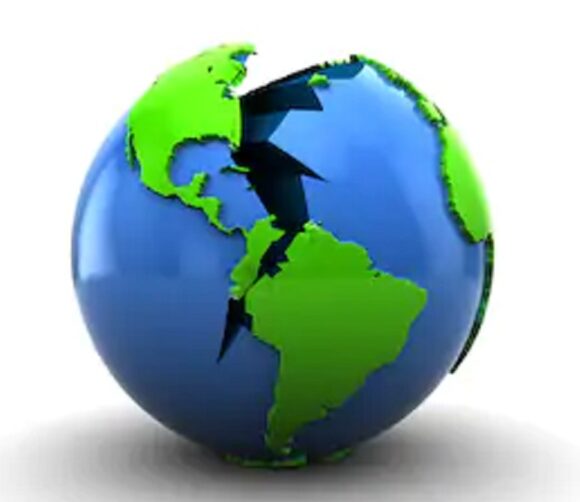

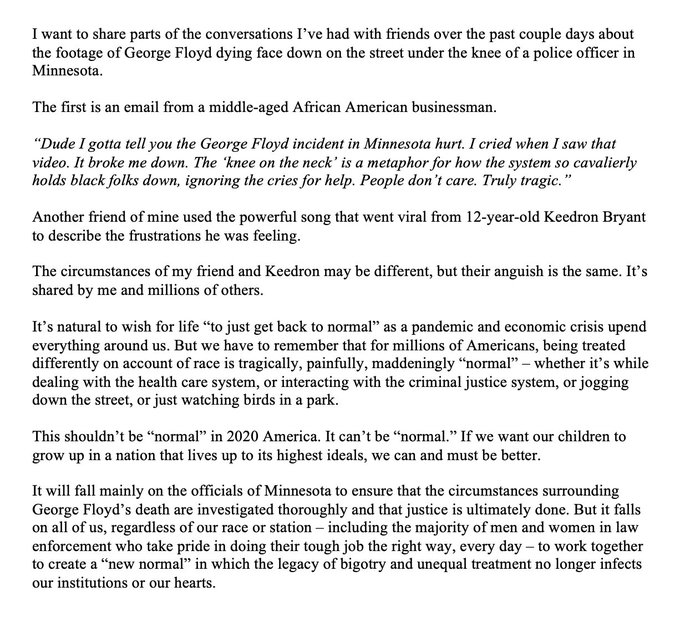 Barack Obama – Statement on the Death of George Floyd
Barack Obama – Statement on the Death of George Floyd
